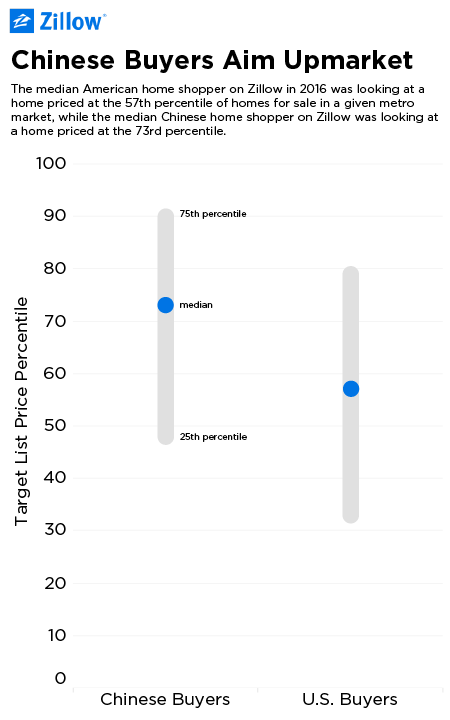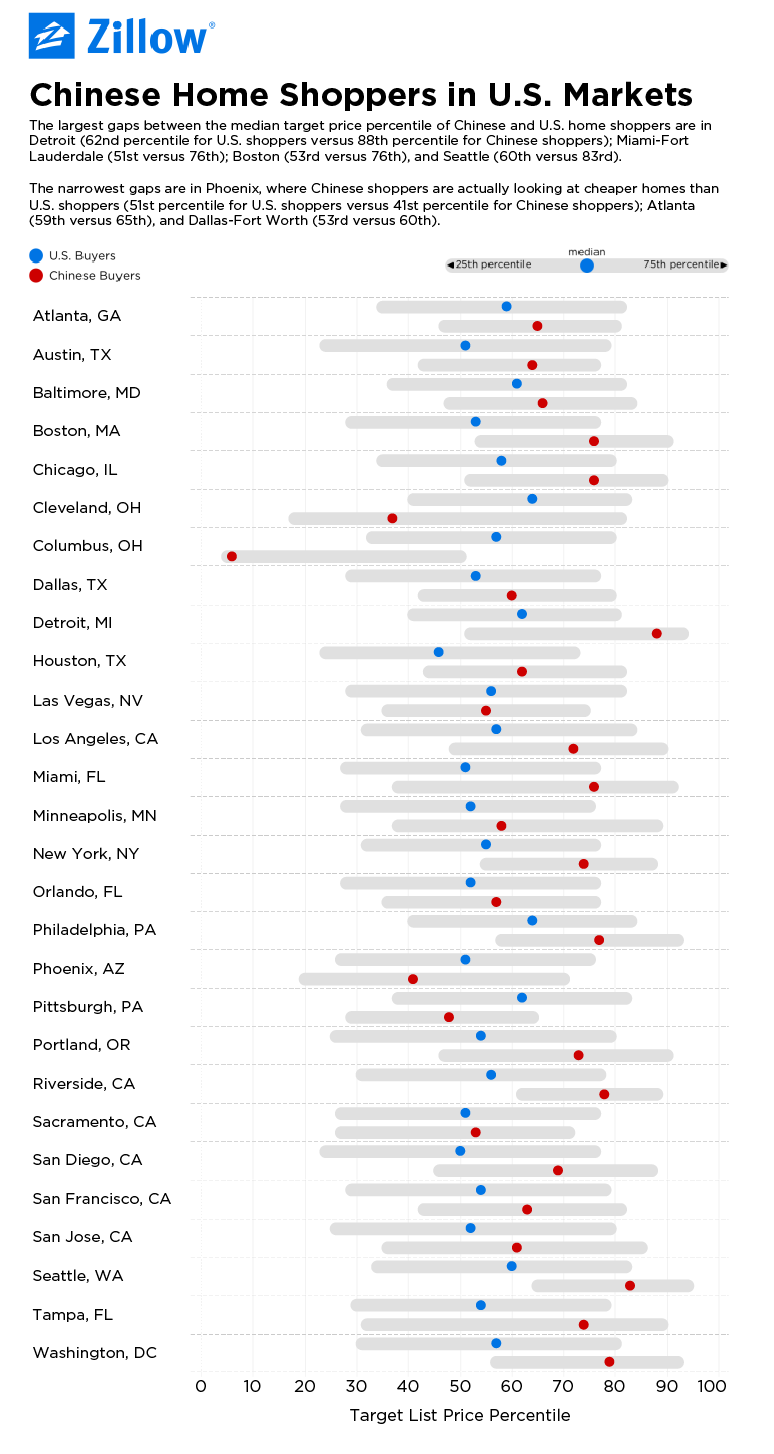Are Home Buyers From China Competing With Americans?
Almost a third of Chinese home shoppers focus on six expensive coastal markets -- and they're overwhelmingly interested in higher-priced homes than U.S. home shoppers.

Almost a third of Chinese home shoppers focus on six expensive coastal markets -- and they're overwhelmingly interested in higher-priced homes than U.S. home shoppers.

In recent years, international home shoppers have emerged as a highly visible driver of housing market demand in a number of global cities including London, New York, Vancouver, Toronto and Miami. Some residents and local policymakers are concerned about the perceived competition these international home shoppers pose for local buyers. In response, a number of cities have enacted or considered new regulations or restrictions on international home buyers with the aim of preserving affordability for local buyers and slowing fast-moving markets.
We test the perception of competition using data about Chinese home shoppers on Zillow in 2016. The results suggest that international home shoppers compete primarily with more affluent locals since they tend to target high-priced homes.
Chinese home shoppers are overwhelmingly interested in higher-priced homes than U.S. home shoppers: In 2016, the median American home shopper on Zillow was looking at a home listed at $253,000, while the median Chinese home shopper on Zillow was looking at a home listed at more than twice that at $572,000.
Some of this gap is driven by the markets where these home shoppers are searching. Chinese shoppers looking at homes in the United States tend to focus on a handful of pricey coastal markets including San Jose, San Francisco, Seattle, Los Angeles, San Diego and Boston. In 2016, 32.3 percent of Chinese home shoppers on Zillow focused on these six markets, compared to 7.5 percent of U.S. home shoppers.
But the gap remains even after controlling for geographic differences in where home shoppers are searching. The median American home shopper on Zillow in 2016 was looking at a home priced at the 57th percentile of homes for sale in a given metro market, while the median Chinese home shopper on Zillow was looking at a home priced at the 73rd percentile.


The 16 percentage-point gap between the medians suggests that Chinese home shoppers are competing primarily with more affluent American home shoppers nationwide. Of course, there is substantial variation across metro markets.
The largest gaps between the median target price percentile of Chinese and U.S. home shoppers are in Detroit (62nd percentile for U.S. shoppers versus 88th percentile for Chinese shoppers); Miami-Fort Lauderdale (51st versus 76th); Boston (53rd versus 76th), and Seattle (60th versus 83rd).
The narrowest gaps are in Phoenix, where Chinese shoppers are actually looking at cheaper homes than U.S. shoppers (51st percentile for U.S. shoppers versus 41st percentile for Chinese shoppers); Atlanta (59th versus 65th), and Dallas-Fort Worth (53rd versus 60th).
In general, markets with more Chinese home shoppers show a larger gap in the target price tier of U.S. and Chinese home shoppers. In other words, in the markets with the most Chinese home shoppers, there is the least direct competition between the average target prices of Chinese and U.S. home shoppers.


Figure 3 compares shopping patterns of Chinese and U.S. buyers by price point across metros. The horizontal axis shows the popularity of each market among Chinese shoppers relative to its popularity among U.S. shoppers. Markets that are more popular with Chinese shoppers are toward the right and markets that are less popular among Chinese shoppers are toward the left. The vertical axis shows markets where Chinese shoppers are looking at more expensive homes that U.S. shoppers (top), and where Chinese shoppers are interested in lower priced homes (bottom).
On average, the target price tier of Chinese home shoppers is highest (and furthest from the target price tier of U.S. home shoppers) in the U.S. markets that are most popular for Chinese home shoppers.
We compared the homes that Chinese and U.S. home shoppers are most interested in on Zillow. For homes listed for sale on Zillow in 2016, we computed a percentile based on list price within each metro and for each month. We then combined these data with the number of visitors to Zillow.com who viewed a particular listing, distinguishing users with an IP address in the United States from users with an IP address in the People’s Republic of China.[1]
Weighting by the distribution of visitors from each country who viewed a particular listing, we are able to compare the median price – and more interestingly, the median price percentile – of for-sale homes viewed by U.S. and Chinese home shoppers. To the extent that listings are reflective of a particular consumer’s target price point, this should provide a strong signal of a home shopper’s intent.
To measure the popularity of a particular market for each home shopper group, we looked at the number of visitors to for-sale homes on Zillow from each country relative to the total number of for-sale listings in a given market. We then scaled and took the ratio of these two values to measure markets where Chinese home shoppers have an outsized or undersized presence relative to U.S. home shoppers.
Related:
[1] Because of the size of the search data, and to facilitate computing efficiency, we performed the analysis for 30 randomly selected days in 2016.
[1] Because of the size of the search data, and to facilitate computing efficiency, we performed the analysis for 30 randomly selected days in 2016.